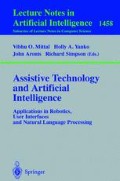Abstract
This paper describes the goals and research directions of the University of Texas Artificial Intelligence Lab's Intelligent Wheelchair Project (IWP). The IWP is a work in progress. The authors are part of a collaborative effort to bring expertise from knowledge representation, control, planning, and machine vision to bear on this difficult and interesting problem domain. Our strategy uses knowledge about the semantic structure of space to focus processing power and sensing resources. The semi-autonomous assistive control of a wheelchair shares many sub-problems with mobile robotics, including those of sensor interpretation, spatial knowledge representation, and real-time control. By enabling the wheelchair with active vision and other sensing modes, and by application of our theories of spatial knowledge representation and reasoning, we hope to provide substantial assistance to people with severe mobility impairments.
This work has taken place in the Qualitative Reasoning Group at the Artificial Intelligence Laboratory, The University of Texas at Austin. Research of the Qualitative Reasoning Group is supported in part by NSF grants IRI-9504138 and CDA 9617327, by NASA grant NAG 9-898, and by the Texas Advanced Research Program under grants no. 003658-242 and 003658-347.
Preview
Unable to display preview. Download preview PDF.
References
J. R. Anderson. Spreading activation. In J. R Anderson and S. M. Kosslyn, editors, Tutorials in Learning and memory: Essays in honor of Gordon Bower. W.H. Freeman, 1984.
D.H. Ballard. Animate vision. Artificial Intelligence, 48:57–86, 1991.
W.S. Gribble. Slow visual search in a fast-changing world. In Proceedings of the 1995 IEEE Intl. Symposium on Computer Vision (ISCV-95), 1995.
W.S. Gribble. ARGUS: a distributed environment for real-time vision. Master's thesis, University of Texas at Austin AI Lab, Austin, Texas, 1995.
W.S. Gribble, R.L. Browning, and B.J. Kuipers. Dynamic binding of visual percepts for robot control. Unpublished manuscript, 1997.
G.D. Hager. Task-directed sensor fusion and planning: a computational approach. Kluwer Academic Publishers, 1990.
A. Bandopadhay J. Aloimonos and I. Weiss. Active vision. Int. J. Computer Vision, 1:333–356, 1988.
B. Kuipers. A hierarchy of qualitative representations for space. In Working papers of the Tenth International Workshop on Qualitative Reasoning about Physical Systems (QR-96). AAAI Press, 1996.
B. Kuipers and Y. T. Byun. A robot exploration and mapping strategy based on semantic hierarchy of spatial representations. Journal of Robotics and Autonomous Systems, 8:47–63, 1991.
B. J. Kuipers and T. Levitt. Navigation and mapping in large scale space. AI Magazine, 9(2):25–43, 1988. Reprinted in Advances in Spatial Reasoning, Volume 2, Su-shing Chen (Ed.), Norwood NJ: Ablex Publishing, 1990.
D. McDermott and E. Davis. Planning routes through uncertain territory. Artificial Intelligence, 22:107–156, 1984.
D.M. Pierce and B. Kuipers. Map learning with uninterpreted sensors and effectors. Artificial Intelligence, 92:169–227, 1997.
C.E. Thorpe, editor. Vision and Navigation: the Carnegie-Mellon Navlab. Kluwer Academic Publishers, 1996.
A. Treisman. Features and objects. In A. Baddeley and L. Weiskrantz, editors, Attention: Selection, Awareness and Control. Clarendon Press, 1993.
Author information
Authors and Affiliations
Editor information
Rights and permissions
Copyright information
© 1998 Springer-Verlag Berlin Heidelberg
About this chapter
Cite this chapter
Gribble, W.S., Browning, R.L., Hewett, M., Remolina, E., Kuipers, B.J. (1998). Integrating vision and spatial reasoning for assistive navigation. In: Mittal, V.O., Yanco, H.A., Aronis, J., Simpson, R. (eds) Assistive Technology and Artificial Intelligence. Lecture Notes in Computer Science, vol 1458. Springer, Berlin, Heidelberg. https://doi.org/10.1007/BFb0055978
Download citation
DOI: https://doi.org/10.1007/BFb0055978
Published:
Publisher Name: Springer, Berlin, Heidelberg
Print ISBN: 978-3-540-64790-4
Online ISBN: 978-3-540-68678-1
eBook Packages: Springer Book Archive

